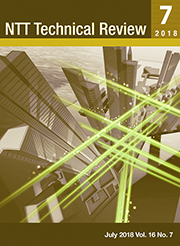
You need Adobe Reader 7.0 or later in order to read PDF files on this site.
If Adobe Reader is not installed on your computer, click the button below and go to the download site.

|

Feature Articles: Forefront of Research on Integrated Nanophotonics-
 Nanophotonic Technologies for On-chip Photonic Integration Nanophotonic Technologies for On-chip Photonic Integration

Abstract
Our research group has been conducting basic research that seeks to introduce optical networking technology in processor chips. Using nanophotonic technology as represented by photonic crystals as the base, we are researching nanophotonic integration technologies to microminiaturize optical devices, drastically reduce energy consumption, and create a variety of new functions. In the Feature Articles in this issue, we introduce our latest achievements in creating nanophotonic devices and our efforts in developing new optical computing technologies using nanophotonics as the base.
-
 Ultralow-capacitance Optoelectronic Converters Using a Photonic Crystal Ultralow-capacitance Optoelectronic Converters Using a Photonic Crystal

Abstract
The fusion of optical technology and electronic circuitry is the key to increasing capacity in any type of information processing, but optoelectronic integrated processing on a chip requires compact and energy-efficient photodetectors (optical-to-electrical (OE) converters) and optical modulators (electricalto-optical (EO) converters). This article introduces such OE/EO converters that are implemented using a photonic crystal nanostructure and thus feature low capacitance and an extremely low energy cost.
-
 Toward Application of Plasmonic Waveguides to Optical Devices Toward Application of Plasmonic Waveguides to Optical Devices

Abstract
The size of a plasmonic waveguide is not limited by the optical wavelength. This enables plasmonic waveguides on the order of several tens of nanometers in length, which is not possible with dielectric waveguides, and exceptionally strong light confinement and efficient interaction with nanomaterials that have various unique properties become possible. However, such waveguides are not easily introduced in optical integrated circuits, so a three-dimensional plasmonic mode converter is required.
-
 Compound Semiconductor Nanowire Laser Integrated in Silicon Photonic Crystal Compound Semiconductor Nanowire Laser Integrated in Silicon Photonic Crystal

Abstract
Compound semiconductor nanowires were integrated in silicon photonic crystals to form nano-cavities in arbitrary places, achieving the first nanowire laser that oscillates continuously at communication wavelengths. High-speed modulation at 10 Gbit/s was demonstrated. This laser is the ultimate heterostructure material hybrid device, having gain material only within the cavity.
-
 Control of Light with Exceptional Points in Coupled Photonic Crystal Lasers Control of Light with Exceptional Points in Coupled Photonic Crystal Lasers

Abstract
Controlling light in a miniature optical circuit is challenging due to constraints that do not apply to free space or fiber-optic elements. Studies are underway to find ways to overcome such constraints by applying fundamental optical responses of amplification and absorption, which produce exceptional points that cause novel phenomena. These studies form a new and rapidly growing field called parity-time (PT)-symmetric optics and have been attracting a lot of attention. In this article, we describe the research background and the basic concept of PT-symmetric optics. We then introduce NTTˇÇs efforts to achieve the ability to control light by using PT symmetry in photonic crystal devices.
-
 Ultralow-latency Optical Circuit Based on Optical Pass Gate Logic Ultralow-latency Optical Circuit Based on Optical Pass Gate Logic

Abstract
A novel light speed computing technology has been developed by NTT, Kyoto University, and Kyushu University that employs nanophotonic technology in critical paths and thus overcomes the problem of operational latency that is the chief limiting factor in conventional electronic circuits. The ultimate objective of this work is to develop an ultrahigh-speed optoelectronic arithmetic processor. This article provides an overview of our recent work and describes the successful implementation of this novel optical computing technology.
Regular Articles-
 Cloud Native SDx Control Technology Cloud Native SDx Control Technology

Abstract
As various services are introduced in the cloud environment, service provision can be simplified and accelerated through end-to-end automatic control of network services and the cloud environment that includes applications for providing services. This article provides an overview of cloud native SDx (software-defined anything) control technology and describes a technical verification of automatic control technology.
Global Standardization Activities-
 Standardization Trends of Virtualized Access Systems by the Broadband Forum Standardization Trends of Virtualized Access Systems by the Broadband Forum

Abstract
Various organizations are studying the introduction of virtualization technologies to access systems in order to achieve flexible, agile, and cost-effective adaptation of access networks to a diverse range of services. This article reports on the standardization trends of virtualized access systems by the Broadband Forum (BBF) and explains related activities happening at the NTT laboratories.
Short Reports
External Awards/Papers Published in Technical Journals and Conference Proceedings
|